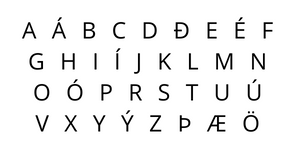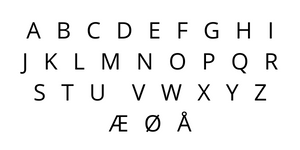Icelandic and Norwegian: The Similarities and the Differences
Icelandic and Norwegian are languages that evolved from Old Norse, an ancient language spoken by the Vikings.
Iceland was first settled in 874 by Ingólfur Arnarson, a Norseman who came from a city that is today part of Norway.
Because of its secluded location, as an Island nearly 1000 km from Norway, Iceland has been relatively sheltered from foreign linguistic influences. Compared to Norwegian, the Icelandic language has remained much closer to Old Norse.
Icelandic and Norwegian have had over 1000 years to diverge in different directions from their common linguistic ancestor. This raises the question as to how similar contemporary Icelandic is to contemporary Norwegian.
Vocabulary comparison
Similar vocabulary words
There are a lot of similar vocabulary words between Icelandic and Norwegian. These shared words are often spelled slightly differently.
Below are some examples of similar words. Notice that when an Icelandic word ends in ‘ur’, the corresponding Norwegian word often has that ending removed.
| English | Icelandic | Norwegian |
|---|---|---|
| peace | friður | fred |
| forest | skógur | skog |
| evening | kvöld | kveld |
| expensive | dýrt | dyrt |
| mountain | fjall | fjell |
| yellow | gulur | gul |
| white | hvítur | hvit |
| seasons | árstíðir | årstider |
| money | peningar | penger |
| shoes | skór | sko |
| friend | vinur | venn |
| calm | rólegur | rolig |
| cheese | ostur | ost |
Pairs of words that appear to be similar yet have completely different meanings are called “false friends” in the context of language learning.
Most of the vocabulary words which appear to be similar between Icelandic and Norwegian do in fact have the same meanings. However here is an example of an Icelandic-Norwegian vocabulary “false friend”:
In Icelandic, the verb “að knúsa” means “to hug”, while in Norwegian the verb “å knuse” means “to crush”
Different attitudes towards foreign loanwords
Icelanders go to great lengths to preserve their language. Rather than adopt foreign (mostly English) words with Icelandic spelling, the Icelandic language committee develops entirely new words based on the linguistic conventions of Icelandic.
Many of these words are tech-related — email (tölvupóstur), hashtag (myllumerki), and podcast (hlaðvarp). Icelandic “refuses” to simply adopt them directly from English.
Norwegian is more open to directly incorporating foreign words as loanwords. And, every now and then, a loanword slips into Icelandic.
| English | Norwegian | Icelandic |
|---|---|---|
| computer | datamaskin | tölva |
| e-post | tölvupóstur | |
| hashtag | emnekagg | myllumerki |
| airplane | fly | flugvél |
| to swim | å svømme | Að synda |
| cool | kul | kúl |
| automatically | automatisk | sjálfkrafa |
| smart | smart | klár |
| telephone | telefon | sími |
The German language has had more influence on Norwegian than on Icelandic
The Norwegian language was influenced by German during the period of the Hanseatic League, which was an organization of merchants during the middle ages.
Hanseatic League was a commercial organization based in the North German cities of Hamburg, Lübeck, and Bremen. The Hanseatic League had trading stations in several northern European cities, including the Norwegian city of Bergen.
Here are some examples of Norwegian words which come from German. The corresponding Icelandic words generally come from Old Norse and not German.
| English | Norwegian | German | Icelandic |
|---|---|---|---|
| work | arbeid | Arbeit | vinna |
| teacher | lærer | Lehrer | kennari |
| famous | berømt | berühmt | frægur |
| careful | forsiktig | vorsichtig | varkár |
| important | viktig | wichtig | mikilvægt |
| dangerous | farlig | gefährlich | hættulegt |
| war | krig | Krieg | stríð |
Icelandic and Norwegian: a common origin
Norwegians today speak a language that is quite different from Old Norse, whereas Icelanders speak a language that is nearly identical to Old Norse.
While it might be easier for Icelanders to speak a bit of Norwegian than it is for them to take on Danish or Swedish — modern Norwegian and Icelandic are still quite different from one another.
What happened? How did the two languages diverge?
At the time of Iceland’s settlement, Norway and Iceland were closely connected because the Viking settlers in Iceland came primarily from Norway, back when Vikings ran the world. Well, they ran the North Atlantic, at least...
The history of this connection is detailed by Icelandic historian, poet, and politician Snorri Sturluson, in the Snorra Edda, also called the Prose Edda, written in the early 13th century, which details much of Iceland’s settlement history.
Early on, Norwegians and Icelanders both spoke Old Norse. Their languages didn’t start to diverge until around the 14th century.
Influences from nearby countries (Germany, Denmark, Sweden) gradually started changing the Norwegian language.
In contrast, Iceland, being remote and isolated, was preserved from these influences. Icelandic grammar hasn’t changed much in the past seven hundred years or so.
In fact, the language spoken in Iceland today is almost identical to the Old Norse spoken by the Viking settlers hundreds of years ago.
Icelanders of today find it pretty easy to read Old Norse texts, while modern-day Norwegians would probably have a very hard time with it.
Different forms Of modern Norwegian and modern Icelandic
Modern Norwegian has two different written languages, “nýnorska” and “bókmál.”
There are also many different dialects within Norway (population: 5.379 million) depending on the location of the speaker in the country.
Iceland (population approximately 366,000), on the other hand, has only one form of the written language, and a tiny variation in the dialect between the general population and the Icelanders who reside in the northern part of the island.
Icelandic alphabet vs. Norwegian alphabet
Icelandic and Norwegian use similar alphabets, but each of these languages has a few letters that the other language does not have.
The Icelandic alphabet The Norwegian alphabet
The Norwegian alphabet

The letters Ð and Þ are unique to Icelandic and derive from Old Norse. Icelandic also includes many accented forms of vowels, such as Á, É, Í, and so on.
Norwegian uses the letters Ø and Å, which are present in the other Scandinavian languages, but not in Icelandic.
In both languages, the letters C, Q, W, X, and Z are used only/primarily in foreign loan words.
Articles in Icelandic vs Norwegian
In English, articles are among the most frequently used words. The English language has both definite articles (“the”) and indefinite articles (“a” and “an”).
Indefinite articles exist in Norwegian, but they do not exist in Icelandic.
In Icelandic and in Norwegian, the definite article is usually added to the end of the word (it is a suffix).
| Vocabulary for the examples: | |
| English | language |
|---|---|
| Norwegian | språk |
| Icelandic | tungumál |
| Indefinite articles: | |
| English | I speak a language |
| Norwegian | Jeg snakker et språk |
| Icelandic | Ég tala tungumál |
| Definite articles: | |
| English | I speak the language |
| Norwegian | Jeg snakker språket |
| Icelandic | Ég tala tungumálið |
Grammatical cases have been preserved in Icelandic but not in Norwegian
Icelandic has preserved many of the complicated grammatical features from Old Norse, while these have mostly disappeared from Norwegian.
For instance, Icelandic has four grammatical cases: nominative, accusative, dative, and genitive.
Old Norwegian had grammatical cases. However, between the 12th and the 16th century, the Norwegian language underwent considerable changes which included the loss of grammatical cases.
The example phrases below show how nouns in Icelandic are inflected based on grammatical cases. Notice how in the Norwegian phrases the noun is not inflected.
| Nominative: | |
| English | a cat plays |
|---|---|
| Norwegian | en katt leker |
| Icelandic | köttur leikur sér |
| Accusative: | |
| English | I see a cat |
| Norwegian | Jeg ser en katt |
| Icelandic | Ég sé kött |
| Dative: | |
| English | I give food to a cat |
| Norwegian | Jeg gir mat til en katt |
| Icelandic | Ég gef ketti mat |
More straightforward verb conjugations in Norwegian compared to Icelandic
Conjugation is particularly straightforward in Norwegian, given that verbs maintain the same form for all subject pronouns. This is not the case in Icelandic. The ending of Icelandic verbs changes depending on the subject pronoun.
For example, here are some conjugation tables for the verb “to read” in Norwegian and Icelandic. Notice how much simpler the Norwegian conjugation is, compared to Icelandic.
Choosing between learning Norwegian and Icelandic
For English speakers, Icelandic is a hard language to learn, whereas Norwegian is a relatively easy language to learn.
The choice between learning Icelandic and Norwegian also depends on the learner's affinity for grammar. Language learners who enjoy grammatical concepts will enjoy learning Icelandic; those who dislike grammar may have a more pleasant time learning Norwegian.
In any case, due to the similarities in vocabulary, learning either Icelandic or Norwegian would make learning the other one easier later on.
ConclusionIcelandic was similar to Old Norwegian, but it is much less similar to the Norwegian language used today.
Still Icelandic and Norwegian have many similar vocabulary words in common. It is mostly in terms of grammar that these two languages differ the most.
Icelandic has kept many of the complicated grammatical features which existed in old Norse, while many of these features have disappeared from Norwegian.
This explains why Icelandic is one of the hardest languages for English speakers to learn, whereas Norwegian is one of the easiest languages for English speakers to learn.
